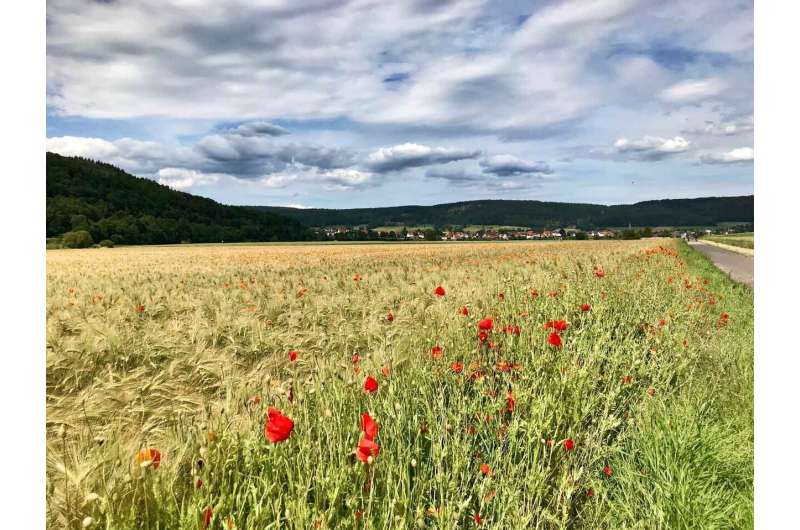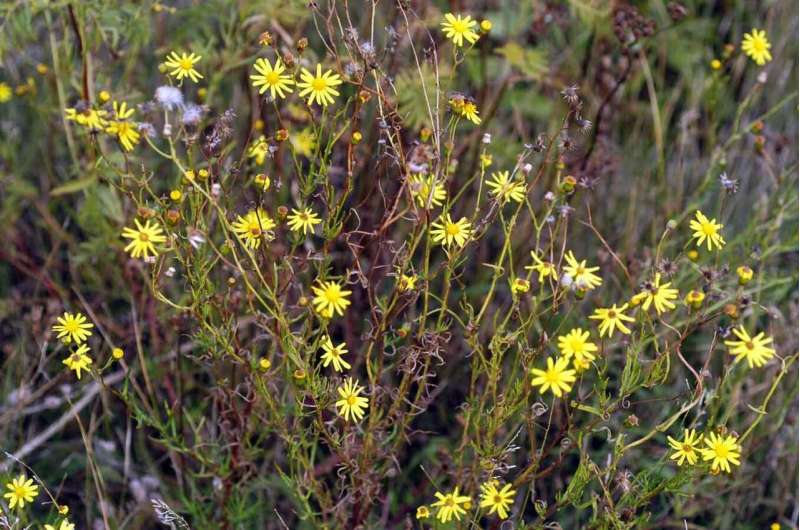The study shows that even species that are considered widespread, such as the corn poppy (Papaver rhoeas), are steadily declining in Germany. Credit: Sebastian Lakner
In the last 60 years, plant diversity across Germany decreased by an average of 15% in over 70% of the more than 2000 species examined. This most comprehensive analysis of plant data from Germany ever conducted involved researchers from the German Centre for Integrative Biodiversity Research (iDiv), the universities of Jena, Halle and Rostock, the Helmholtz Centre for Environmental Research (UFZ) as well as the Federal Agency for Nature Conservation (BfN).
In an area covering the whole of Germany, in every grid field of approximately 5 by 5 kilometers, the decline in species diversity averages around 2% per decade. Especially vulnerable are the archaeophytes; species brought to Germany by humans but before the discovery of America. Among others, these include a large proportion of accompanying field flora, such as the corn marigold and the large Venus's looking glass, but also species such as the narrow-leaved rattle and the perennial goosefoot. On the other hand, many neophytes—those species that reached Germany after 1492 were also able to spread, including the Himalayan balsam and the narrow-leaved ragwort. The results of this study make it clear that even this increase could not compensate for the loss in the number of species per unit of area.
Study shows gradual biodiversity decline in Germany
For this study, the necessarily large and heterogeneous data sets were brought together, for the first time in Germany, and reliably statistically evaluated. Distribution data from 2136 of the over 4300 plant species established in Germany were included in the calculations. Species with very low reporting frequencies were not included. The foundation for this was the FlorKart database, in which the Federal Agency for Nature Conservation has collated data on the distribution of flora in Germany. This data is predominantly the result of intensive mapping work by volunteers; an endeavor which is indispensable for nature conservation. The data was supplemented by further data sets from universities and other scientific institutions, but also by information on the presence of plants from private individuals. Information gaps were filled by calculating the probability of plant occurrence.
BfN President Prof Dr. Beate Jessel concludes: "This clearly shows, once again, that we have to rethink our approach to nature and landscape; after all, the population declines proven by the study extend over the whole of Germany. This leaves no doubt; we need a broad-based approach to agriculture and forestry, which together occupy 80% of the area of Germany. This demonstrates that there's an urgent need for more nature-compatible forms of land use."
Man-imported species are on the increase in Germany, but their numbers cannot replace the loss of plant species. The narrow-leaved rattle (Senecio inaequidens) is originally native to southern Africa, but is now spread worldwide. Credit: Helge Bruelheide
Plant species brought in by humans (neophytes) are gaining ground
"The degree of clarity in these results really surprised us. They paint a very dismal picture of the state of plant diversity in Germany," says first author Dr. David Eichenberg of iDiv. "This study has confirmed that the declines are not limited to already rare or particularly endangered species, but that a gradual reduction of biodiversity in the majority of plant species in Germany has obviously been happening for a long time."
The authors consider it likely that the observed decline in plant diversity has a major impact on biodiversity and ecosystem services. Due to the often very complex relationships between, for example, food webs and the cascade effect, such losses can have very serious consequences. It is evident that the intricate interrelationships between insects are affected, leading to decreases in both insect diversity and abundance.
However, the study also shows that data availability must continue to be improved in order to identify even subtle biodiversity losses as early as possible. In order to achieve this, the Federal Agency for Nature Conservation is currently setting out the basis for monitoring semi-frequent plant species in Germany. In contrast to rare species, whose populations and occurrence are often well surveyed, with current recording methods, declines in semi-frequent and common species are only noticed late, or not at all.
More information: Global Change Biology, DOI: 10.1111/gcb.15447
Journal information: Nature Conservation , Global Change Biology
Provided by German Centre for Integrative Biodiversity Research (iDiv) Halle-Jena-Leipzig

























